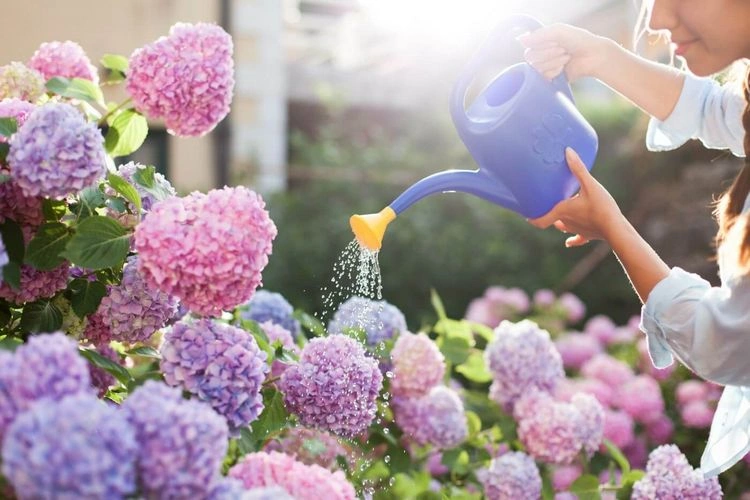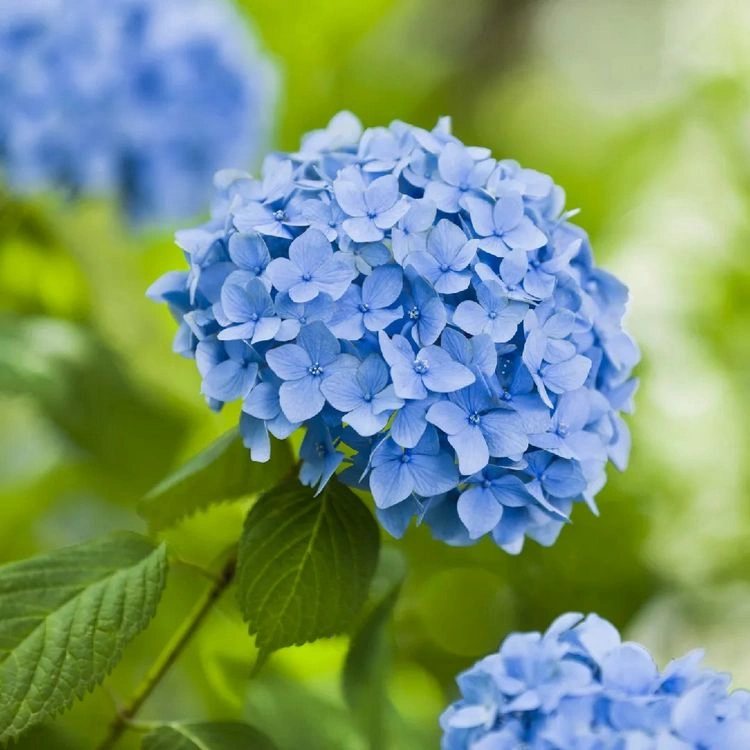If you have planted hydrangeas in your garden, you may be wondering how the plants can get large flowers and how you can extend the flowering period. Plants like hydrangeas can be very picky, making it difficult to achieve consistently beautiful results. In the following article we will tell you tips and tricks for lush hydrangea blossoms!
Planting hydrangeas – good time
Spring or fall are good times to plant hydrangeas – when temperatures are warm. In spring, you should wait until the last frost has passed and the soil has thawed enough to work without problems before digging. In autumn you should make sure that it is not too late, because a late frost could kill the plant. These ornamental shrubs are at their best between mid-summer and early October.
How to care for hydrangeas – proper watering

Hydrangeas are unanimous in their preference for moist conditions. Her botanical name Hydrangea is made up of the Greek words for “water” (hydra) and “vessel” (angeion) together. But how often should you water hydrangeas? Watch the leaves and you’ll see what’s going on. When a hydrangea plant needs water, you can tell by the leaves hanging down. Wait until nightfall to see if they’ll recover before watering them, as the afternoon heat will also cause the leaves to droop. If you plant your hydrangea in the ground, it will need to be watered at least 3 times a week for the first few weeks to allow it to take root. Be careful not to soak the soil in the garden.
Tips and tricks for lush hydrangea blooms

Hydrangeas require special care when fertilizing. With a soil test you can easily find out which nutrients are missing in your soil. Once you get the results, you can start planning your diet. Once your shrubs are established, they won’t need much extra care when it comes to feeding. Manure or compost, which is introduced into the soil around the base of the plant, is suitable for fertilizing hydrangeas. This method not only gives good results, but also promotes the development of the soil.
Phosphorus is an essential nutrient for all flowering plants. The best fertilizer for flowering shrubs and trees is a fertilizer specially formulated for these plants. There are also slow release fertilizers. Hydrangeas should not be fertilized after August as they prepare for dormancy.
Care tips for hydrangeas in the garden – location

Hydrangeas like morning or evening sun, so they should be planted in partial shade to maximize their flowering potential. Most hydrangeas are known to do better if they get some shade in the afternoon. While your shrubs can suffer from too much shade, too much sun can also kill them. The panicle hydrangea thrives in full light and only needs six hours a day to produce magnificent blooms and lush, green foliage. The other species, on the other hand, do best with just four to six hours of sun per day in slightly shady areas. A hydrangea plant will show signs of sunburn if it gets too much sun. In this case, your plant will save energy by not forming flowers.
Cut back hydrangeas
If you prune your hydrangeas properly, they will bloom larger and more vigorously than they otherwise would. Timing is critical when pruning hydrangeas. Panicle hydrangeas bloom in summer on new shoots, the so-called “new wood”. Cut back panicle hydrangeas by half before spring shoots begin. The pruning stimulates the growth of new shoots and thus increases the formation of flowers. All other hydrangeas, on the other hand, only produce flowers on the “old wood” (the shoots left over from the previous year) in late spring or early summer. These should be cut back soon after the end of the flowering period. If you put it off, you may have to forgo blooms this year. Dead or damaged shoots can be removed at any time.
New hydrangea plants are easily propagated from cuttings obtained during pruning. Because hydrangea cuttings are easy to transplant, two plants can grow from a single cut.
Tips and tricks for lush hydrangea blooms – mulch
It is recommended to mulch the soil next to the shrubs to retain moisture. Mulching around your plants has several benefits. A good layer of mulch helps keep weeds at bay. This may seem small, but the weed is quite aggressive when it comes to depriving other plants of water and nutrients. A layer of mulch also helps in the heat. Keeping the soil moist with a layer of mulch during the hot summer months when hydrangeas are also blooming will help ensure your plant thrives.
Treat fungal diseases in time

Hydrangeas are susceptible to a variety of fungal diseases. This can be the result of a lack of air circulation, damp weather, or the accumulation of leaf litter at the base of the plant. If you notice symptoms of any disease, you should take care of your plant in a timely manner. As previously mentioned, if left untreated, fungal infections can damage not only the buds of your hydrangea plant, but the rest of the plant as well.